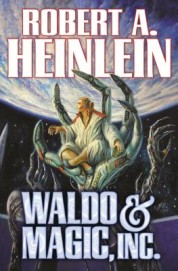 Robert A. Heinlein
Robert A. Heinlein
Baen ($14)
by Ryder W. Miller
Waldo & Magic, Inc., by science fiction pioneer Robert Heinlein, presents two novellas from the early 1940s that were breakthrough works at that time. Heinlein is more famous for the novels he published during the 1960s, especially Stranger in a Strange Land (1961), but he also helped to usher in the Golden Age of Science Fiction that followed the era of the pulps. These short novels are examples of that earlier work.
In the introduction, Heinlein biographer William H. Patterson, Jr. writes, “‘Waldo’ and ‘Magic, Inc.’ are products of the first flush of Heinlein’s personal innovation, welcomed at the time as an escape from the pulp formulas of ’30s space opera.” These books fit more easily into the rubric of “science fantasy” instead of solely science fiction or fantasy, and they are suitable for both bright children and adults out for vicarious fun.
“Waldo” concerns the manufacture of machines named after the inventor that can perform all manner of feats; the reader meets the inventor and tags along for an intriguing tale. “Magic, Inc.” deals with outfits that sell magic as a commodity, and takes place in a strange, archaic-seeming future that not everybody likes. One character complains:
The country had gotten along all right in the old days before magic had become popular and commercially widespread. It was unquestionably a headache in many ways, even leaving out our present troubles with racketeers and monopolists.
The book features a lot of smoky back-room talk from the likes of business “movers and shakers.” There is plenty of action, but what stands out more is the rumination of the characters—it doesn’t quite reach the heights of Heinlein’s The Man Who Sold the Moon, but readers can get lost in this talk.
L. Sprague de Camp admired Heinlein’s “prodigality of invention, his shrewd grasp of human nature and his versatile knowledge of law, politics, business and science.” Fans of Heinlein are in for a treat with these two short novels, which have stayed in publication for over sixty years. Heinlein’s universe was large, and while these stories may not be signature works, they explore his earlier sensibility and are a reflection of his time.

